
The Indian Heaven area has been volcanically active since the Pleistocene age, with the most recent eruption happening around 9000 years ago, creating the Big Lava Bed south of the Indian Heaven. Lava flows paired with melting glacial ice created high, wide, thickly-forested plateaus within the Indian Heaven Wilderness making for great views, many deep lakes, and huckleberries galore.
Indian Heaven Wilderness was created in 1984, gaining its designation in order to protect some 20,960 acres including many lakes, ponds, marshes, and meadows as wilderness. It is home to the Sawtooth Berry fields, the Big Lava Bed, and the Indian Heaven Volcanic fields. It is definitely an area worth exploring.
For almost 10,000 years the Native Americans of Washington State have been travelling to the area, known as “Sahalee Tyee,” meaning “the Chiefs high, heavenly ground.” The Wasco, Umatilla, Wishram, Yakama, Cascade, and Klickitat tribes would come here for an annual harvest gathering, with some tribes coming from as far as Wyoming and Montana to join in. The gathering was an opportunity to bring friends, family, and distant relatives together to trade, fish, hunt, hold rituals, and berry pick. This was a traditional time to harvest fruit for use during the rest of the year, and evenings were reserved for celebration, oral histories, and legends.
Huckleberries were and are especially important to local tribes, as they were a primary food source and a key part of their culture. As we explored Indian Heaven we were delighted to find some of the huckleberries ourselves, enjoying a few moments of reflection on the history of the area.
Indian Heaven Trail #33
Cultus Creek Campground is a great place to camp and use as a home base while adventuring in the Indian Heaven Wilderness. From the Cultus Creek Campground both the Cultus Creek Trail #108 and the Indian Heaven Trail #33 (leading to Deep Lake Trail #33A) are accessed from the campground.
We found the perfect site near the river and away from the road, where we quickly set up base camp. The next morning we woke up early, had a quick breakfast, and started our hike. From our campsite it was relatively easy to access the trail. The trailhead parking lot was quickly beginning to fill, which made us glad that we decided to camp as it gave us built-in parking.
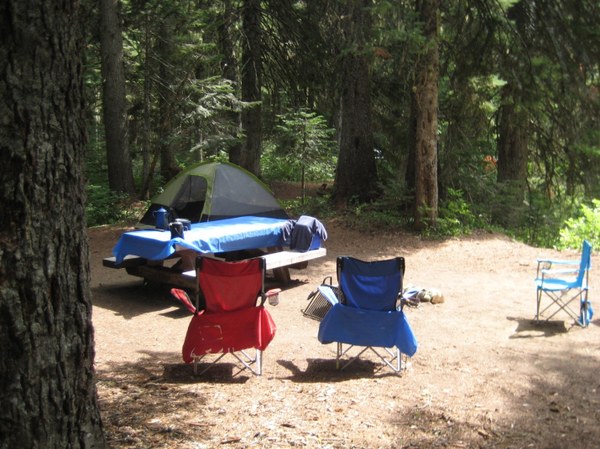 Our campsite. Photo by Regina Robinson.
Our campsite. Photo by Regina Robinson.
The Indian Heaven Trail climbs quickly and steeply through dense forest filled with vanilla leaf, bear grass, huckleberries, white pine, and a few different fir varieties. After gaining 1,000 ft in just 2 miles, we rounded the corner and saw a man sitting on a rock ledge with his booted feet propped up, laptop perched on his legs, with a cuppa joe in one hand and a cell phone in the other. I couldn’t believe my eyes.
I honestly couldn’t believe someone would want to be working here. This was highly unexpected and a tad bit crazy! Maybe a figment of my imagination.... or was it?
Before we could even say hello, the man announced that he often drives up from Trout Lake just for the view, as “this is the best office in the world.” I had to agree, the view here was definitely amazing - Mt. Rainer, Mt. Adams, Sawtooth Mountain, and the Goat Rocks are visible from his “office”. I know I wouldn’t have gotten much work done here, if any, as there were still huckleberries on the bushes to be eaten. And that view!
I was curious about whether he had service. “Yes,” he said, “it’s the only spot in the area.” Much to his amusement, my hiking buddies and I had to check this out. Yup, cell service - yikes! I was seriously hoping this wouldn’t ruin our outdoor adventure. However I was told not to worry, as service was only found right on the ledge. Sure enough, walking the trail in either direction I discovered that it quickly vanished. Needless to say I was quite relieved.
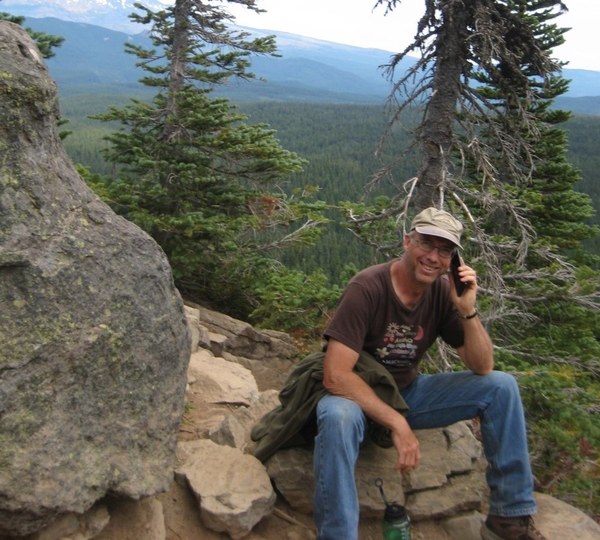 A hiker testing the cell service. Photo by Regina Robinson.
A hiker testing the cell service. Photo by Regina Robinson.
One of my friends hopped on the phone while the rest of us chatted about the lack of biting insects in the Indian Heaven Wilderness on that crisp fall day. Mosquitoes flourish in this area in the summer, making it a bug-spray haven for much of the hiking season. Our laptop-laden friend mentioned that most of the lakes were great for fishing as they’re often stocked with rainbow and brook trout. Something to consider for our next adventure into the area: bring a fishing pole.
Once we left the best office in the world, the trail began to skirt the base of Bird Mountain, where it became less steep and gradually leveled out. The huckleberry bushes were at least four feet tall, dense, and practically growing over the trail. I had a hard time keeping up with my hiking partners because I kept stopping to gorge on ripe, juicy berries. My hands would soon take on the blackish-purple hue that would later be smeared all over my legs and face. Yum!
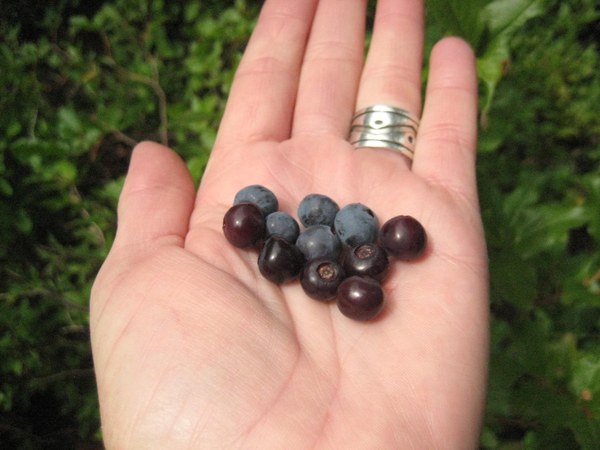 Fresh huckleberries. Photo by Regina Robinson.
Fresh huckleberries. Photo by Regina Robinson.
At 5,100 ft the trail meanders through several small wildflower-filled meadows. Even though it was late fall, the flowers were putting on quite the show. You could hear frogs croaking, birds singing, and bees buzzing. This area is magical.
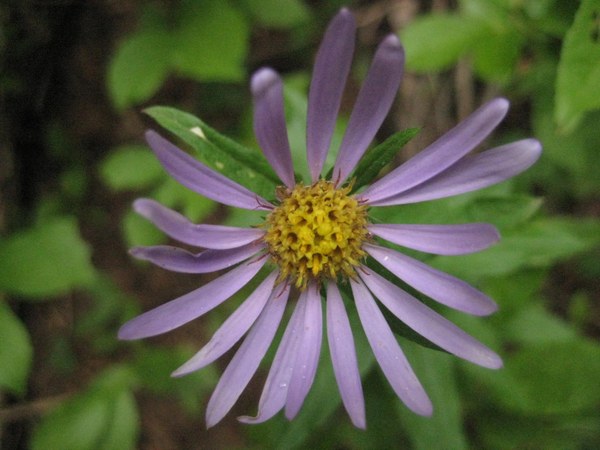 A late-fall wildflower. Photo by Regina Robinson.
A late-fall wildflower. Photo by Regina Robinson.
We came to the junction with the Deep Lake Trail #33, following the trail to a marshy meadow junction where you can travel either left or right. We decided to traverse the lake counterclockwise; turning right, we found ourselves in a marshy, muddy, boggy area filled with frogs and other water critters. Three frogs were resting in the clear, cool lake water with their heads just sticking above the water line. The lake is most definitely an excellent spot for camping, day hiking, lunch, naps in the sun, and a swim. I hopped in and enjoyed a brisk swim – the weather was starting to change so it was a little too cold for as long of a swim as I wanted, but I will certainly revisit the area in the summer for another dip.
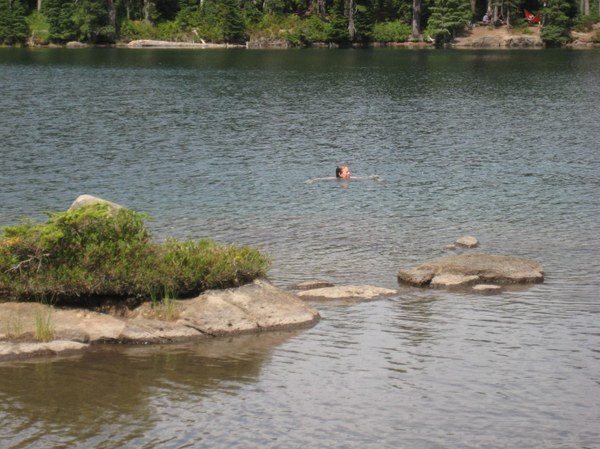 A quick swim. Photo by Regina Robinson.
A quick swim. Photo by Regina Robinson.
Our view of Deep Lake as we headed back down to camp was beautiful. The clouds came in thicker and heavier as the air grew cool and dark. The weather made the lake a little more moody and still; we took a pause for deep reflection.
Hike Beta
Gain: 1000 ft
High Point: 5100 ft
Length: 6.6 miles roundtrip (Unless taking the Indian Heaven Loop Trail, which adds 4+ miles)
Pass/Entry Fee: Use either the Interagency or Forest Service Pass
Permits: Wilderness Permits are self-issued and available at the trailhead
Note: Bears and cougars have been sighted in the area, especially during berry season. Filter all water before drinking.
Bring: 10 Essentials, camera, binoculars, swim supplies
Directions
From Trout Lake, Washington, drive west on Highway 141. At the forest boundary Highway 141 becomes Forest Road 24. Continue west on Forest Road 24 past Peterson Prairie Campground to the intersection with Forest Road 60. At the intersection turn right to stay on Forest Road 24 and continue north past Little Goose Campground, arriving at Cultus Creek Campground approximately 9 miles past the intersection of Forest Road 60.
Cultus Creek Campground Info
The campground has a rustic, primitive feel. The lush vegetation and private spaces make this an ideal spot to stay an adventure.
Elevation: 4,000 ft
Open: Mid-June or early July through October. Call the Mt. Adams Ranger Station for up-to-date information as this campground’s open days are weather-dependent.
Fee: $10.00 a night for a one-tent spot (single). $20.00 a night for a two-tent spot (double). $5.00 extra vehicle fee
Reservations: No
Sites: 46
Facilities: Vault toilets. There is no running water, fire wood, or cell service
Bring: Potable water and firewood; we purchased firewood in Trout Lake
Max stay: 14 days
Nearest town: Trout Lake
Trailheads accessible from the campground: Cultus Creek Trail #108, Indian Heaven Trail #33
 Regina Robinson
Regina Robinson